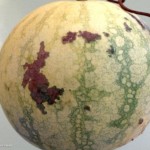Causal Agent: (bacterium ‑ Acidovorax avenae subsp. citrulli)
Fruit symptoms start as water‑soaked spots that rapidly enlarge. Symptoms are generally seen in the light portions of striped fruit (Image 1). The lesions later turn brown and crack (Image 2). The pathogen is introduced to a field by planting contaminated seed or transplants. Within the field, the bacteria spread to healthy plants via rain or overhead irrigation, especially under conditions of high humidity and temperature. The fruit are most susceptible to infection around the time of pollination. As the fruit matures, it becomes resistant to infection. Once introduced into a field, the bacteria can persist on volunteer watermelon or citron (Image 3) plants, or in their seed. Cantaloupe and honeydew melons are also susceptible to this pathogen.
Where this disease has occurred, watermelons and other cucurbit crops should not be replanted in the field for at least one season, crop debris should be plowed under, and volunteer plants destroyed. Cucurbit weeds such as citron melon should also be controlled. Copper based fungicides should be applied on a regular schedule at the time of flowering or earlier, if transplants are used.



